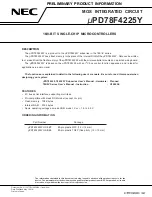
ML51/ML54/ML56
Sep. 01, 2020
Page
226
of 719
Rev 2.00
ML
51
/ML
54
/ML
5
6 S
E
RI
E
S
TECHNI
CA
L
RE
F
E
R
E
NC
E
M
A
NU
A
L
ML51/M
L54
/M
L56
Series
Tec
hnical Reference
Manual
SCnCR0
– SC Control Register
Register
SFR Address
Reset Value
SC0CR0
D6H, Page 0
0000_0000 b
SC1CR0
E6H, Page 2
0000_0000 b
7
6
5
4
3
2
1
0
NSB
T
RXBGTEN
CONSEL
AUTOCEN
TXOFF
RXOFF
SCEN
R/W
R/W
R/W
R/W
R/W
R/W
R/W
R/W
Bit
Name
Description
[7]
NSB
Stop Bit Length
This field indicates the length of stop bit.
0 = The stop bit length is 2 ETU.
1= The stop bit length is 1 ETU.
Note:
The default stop bit length is 2. SC and UART adopt NSB to program the stop bit length.
[6]
T
T Mode
0 = T0 (ISO7816-3 T = 0 mode).
1 = T1 (ISO7816-3 T = 1 mode).
The T mode controls the BGT (Block Guard Time). Block guard time means the minimum bit
length between the leading edges of two consecutive characters between different transfer
directions. This field indicates the counter for the bit length of block guard time. According to
ISO7816-3, in T = 0 mode, the software must clear T bit to 0 for real block guard time = 16.5.
In T = 1 mode, the software must set T bit to 1 for real block guard time = 22.5.
Note:
In T = 0 mode, the receiver will generate the parity flag on PEF(SC0TSR[4]), if parity
error is detected and also drive the parity error signal to transceiver. In T = 1 mode, the
receiver will generate the parity flag on PEF(SC0TSR[4]), if parity error detected, but doesn’t
drive the parity error signal to transceiver.
Note:
The description please see section 6.10.5.2 Error Signal and Character Repetition
[5]
RXBGTEN
Receiver Block Guard Time Function Enable Bit
0 = Receiver block guard time function Disabled.
1 = Receiver block guard time function Enabled.
[4]
CONSEL
Convention Selection
0 = Direct convention.
1 = Inverse convention.
Note 1:
This bit is auto clear to “0”, if AUTOCEN(SCnCR0[3]) is writing “1”
Note 2:
If AUTOCEN(SCnCR0[3]) is enabled, hardware will decide the convention and change
the CONSEL (SCnCR0[4]) bits automatically after SCEN (SCnCR0[0]) =”1”.
















































